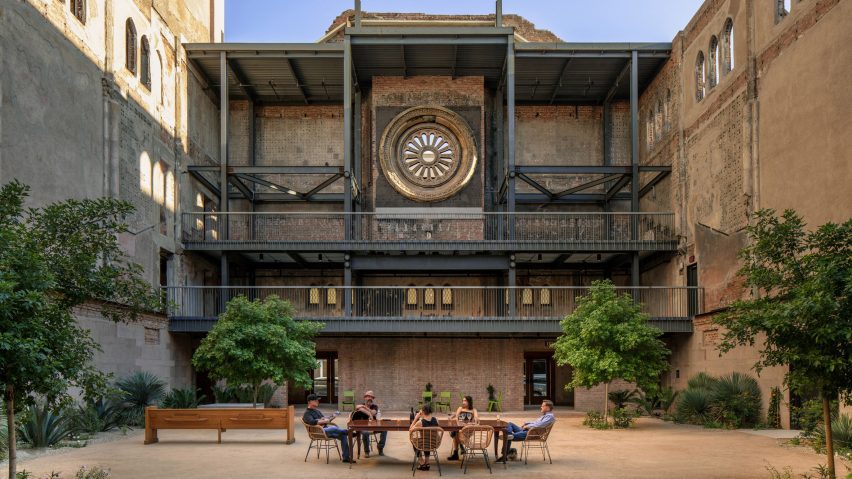Local architecture and landscape studios Jones Studio and Chris Winters Associates have converted an Italian Gothic revival-style church into an event venue in Downtown Phoenix.
Originally built in 1929 by Arizona architecture firm Fitzhugh & Byron, the structure underwent a fire in 1984. It was abandoned and declared a hazard by the city until a local non-profit purchased it and began its revival into today's Monroe Street Abbey event space.
Led by landscape architect Chris Winters Associates and architects Jones Studio, the adaptive reuse project included preserving and stabilizing the building's original architecture and adding new elements, including second and third-floor balconies that look out over a central courtyard.
The structure consists of a four-storey main building and a seven-storey bell tower, which sits at the church's front corner. A two-storey, stucco addition was added to the building's west side in the late 1940s, and continued the Gothic revival style language of the building's facade.
It is organized around a central courtyard, with a semi-enclosed passageway and upper-floor hallways that run along its perimeter and connect to various rooms throughout the building's four storeys.
The courtyard was once an enclosed auditorium, but due to the 1980s fire, the roof was burned and never replaced, leaving it open to elements as it exists today.
Chris Winters Associates and Jones Studio largely focused the project on converting this central space into a 600-person capacity performance and events area, while updating the surrounding rooms into a ballroom, greenroom and areas for future galleries, restaurants, studios and offices.
Overall, the team sought to respect the building's history by leaving some of the elements "seemingly untouched" while updating the structure and integrating ADA accessibility and new utility systems.
"We made a conscious choice to adopt an approach to preservation that respects the history of the Abbey and reveals the impact of time by leaving areas of the building seemingly untouched and juxtaposing contemporary materials with the historic shell," said Jones Studio project architect Maria Salenger.
"While stabilizing the building and making it appropriate for contemporary usage," she continued.
Led by EverGreene Architectural Arts, preservation efforts throughout the building included restoration of the central, recessed rose window, salvaging existing doors and windows, repairs to masonry and plaster and "thoroughly" cleaning interior spaces.
In the courtyard, paving was reduced to a minimum and mixed with "decomposed granite". Ash trees and other native species were added to the outdoor space, and a small fountain was added.
Other elements include elevators, stairways, restrooms and a catering kitchen.
The team said it sought to "not only to restore but to reinvent" the structure based on American architect Herb Greene's concept of "armature" described in his book Buildings to Last—Architecture as an Ongoing Art.
"The design emphasizes coexistence of historical integrity and modern utility as a cultural garden in a ruin," said the team.
"It emphasizes the coexistence of historical integrity and modern utility, to make the Abbey an open canvas for community, creativity, and expression."
Future plans for the building include continued updates to the east and north wings for additional leasable space.
Elsewhere in Arizona, Jones Studio recently completed an education centre to highlight the "preciousness" of water and Wendell Burnette Architects completed a corten steel-clad cabin in Sedona.
The photography is by Bill Timmerman
Project Credits:
Owner: Abbey Historic Restoration LP
Architect: Jones Studio-Eddie Jones, Neal Jones, Maria Salenger, Rob Viergutz, Amie Zemmer, Rob Huff
Landscape architect: Chris Winters Associates-Chris Winters, Eric Barrett
Visioning team participants: Herb Greene, Lila Cohen, Michael Johnson
Civil engineer: Cypress Civil Development/Rick Engineering Co, Derick Shumaker
Structural engineer: Slaysman Engineering Co.-Mel Slayman
Mechanical-plumbing engineer: Associated Mechanical Engineers-George Josephs
Electrical engineer /lighting design: Woodward Engineering-Doug Woodward
Acoustical consultant: McKay Contant Hoover-Dave Conant, Matthew Restrepo
Construction Specifications: RLGA Technical Service-Ron Geren
Theatrical consultant: Landry & Bogan-Rose Steele
Historic preservation consultant: EverGreene Architectural Arts-Jeff Evergreene, Mary Slater, Joseph Sembrat, Ean Frank
General contractor: Patry Building Co.-Dan Patry, Jason Cone, Ignacio Arizmendi

